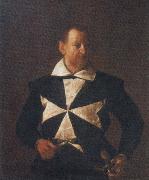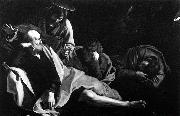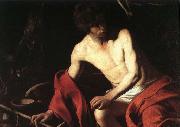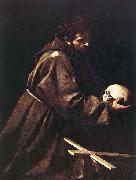
|
Artists
Index
|
||
|
Caravaggio
|
||
|
Cavalier Malta new20/Caravaggio-242776.jpg Gemälde IDENTIFIZIERUNG:: 58165 |
mk261 Florence, Palatina Gallery, Pitti Palace. | |
| |
|
|
|
|
||
|
Portable head David Goliath new20/Caravaggio-389397.jpg Gemälde IDENTIFIZIERUNG:: 58430 |
mk261 canvas 125.5 x 101 cm Museum Verghese | |
| |
|
|
|
|
||
|
Christ in the Garden new21/Caravaggio-632958.jpg Gemälde IDENTIFIZIERUNG:: 62374 |
154 x 222 cm Formerly Kaiser-Friedrich-Museum, Berlin The painting was destroyed in the Second World War, it is known to us today through extant black and white photographs. This was a wonderful composition that caught the instant in which Christ awakes the sleeping apostles. The construction of the scene descends toward the lower right corner. St Peter in particular is shown in a classical position (which has been called Carracci-like), with the containment that characterizes this moment in the artist's career. Author: CARAVAGGIO Title: Christ in the Garden , 1551-1600 , Italian Form: painting , religious | |
| |
|
|
|
|
||
|
St John the Baptist new21/Caravaggio-693982.jpg Gemälde IDENTIFIZIERUNG:: 62375 |
94 x 131 cm Galleria Nazionale d'Arte Antica, Rome In around 1605 Caravaggio dealt with St. John the Baptist in two splendid compositions, one in the Kansas City Gallery, the other in the Galleria Nazionale di Arte Antica in Rome. The former is laid out vertically, the latter horizontally. Both lend themselves to a modernistic reading aimed at pointing out a certain air between contempt and arrogance. In effect what we are dealing with here are splendid exercises in modeling the body through the play of light and shadow. In the version now in Kansas City, the figure is set before a dense curtain of plants; in that in Rome, there is only the trunk of a cypress tree, on the left. Both are admirable feats of painting, and it is understandable that collectors competed with each other for the artist's works. Caravaggio in turn knew how to make apparently uninteresting religious themes into paintings desirable even for his aristocratic patrons. | |
| |
|
|
|
|
||
|
St Francis c. 1606 Oil on canvas new21/Caravaggio-639393.jpg Gemälde IDENTIFIZIERUNG:: 62376 |
125 x 93 cm Galleria Nazionale d'Arte Antica, Rome The founder of the Franciscan Order was the first person to experience the miracle of stigmatization of his own body. In other words, he was marked out by Christ's wounds. Here he is reduced to the ideal state of penance in the wilderness - a state equally valid for saints and pious people. Caravaggio shows no sign of reinterpreting the story unconventionally. His rather traditional approach may derive from the fact that the composition is probably a commission from the papal family. They owned the township known as Carpineto, from where an almost identical second version, stored at present in the Palazzo Venezia, Rome, originated. Stylistically, the painting is very closely related to the Brera Supper in Emmaus, which was probably painted in Latium | |
| |
|
|
|
|
||
| Vorheriger Künstler | ||
|
Also Buy::. For Following Paintings / Artists / Products, Please Use Our Search Online: |










